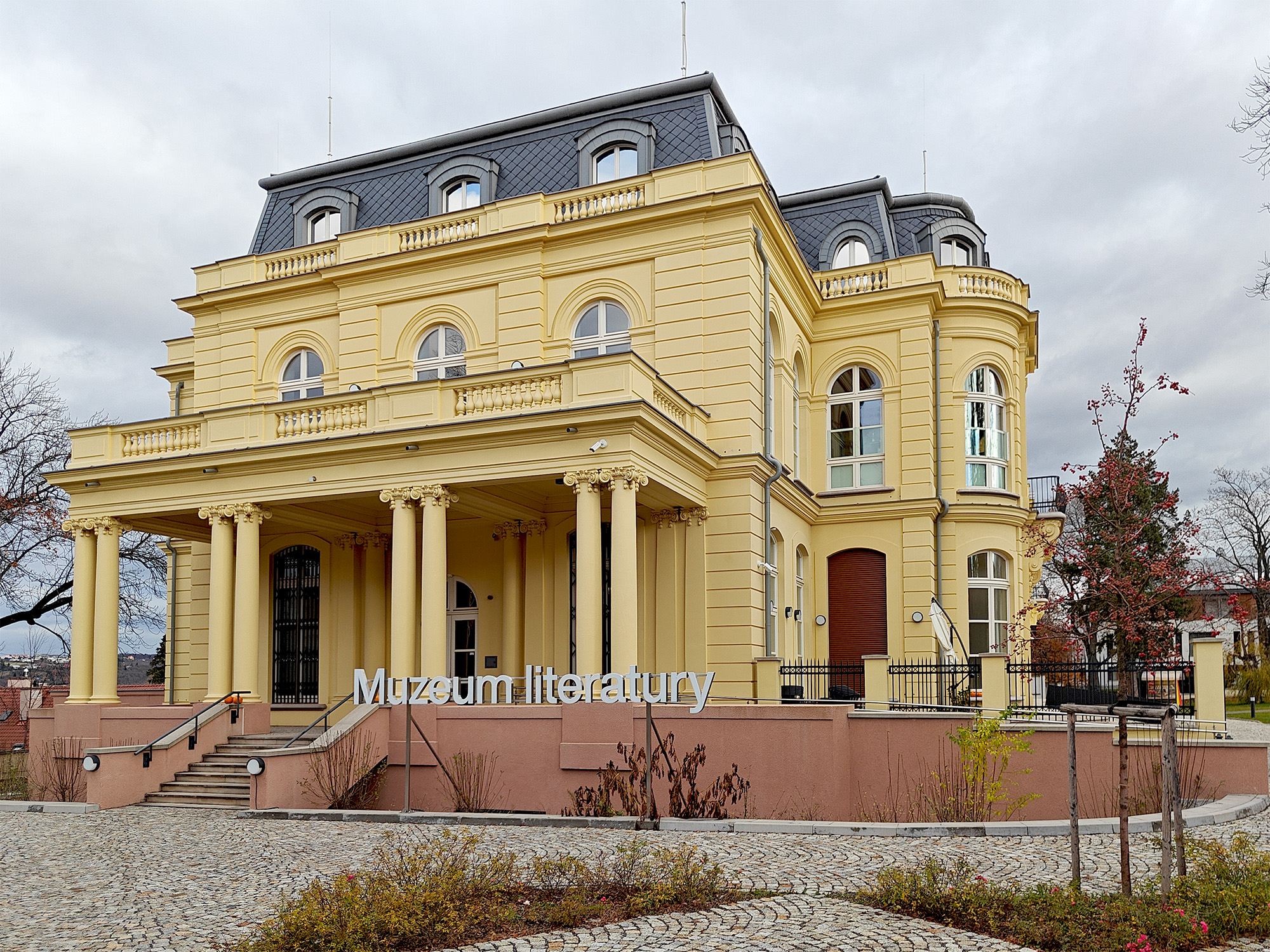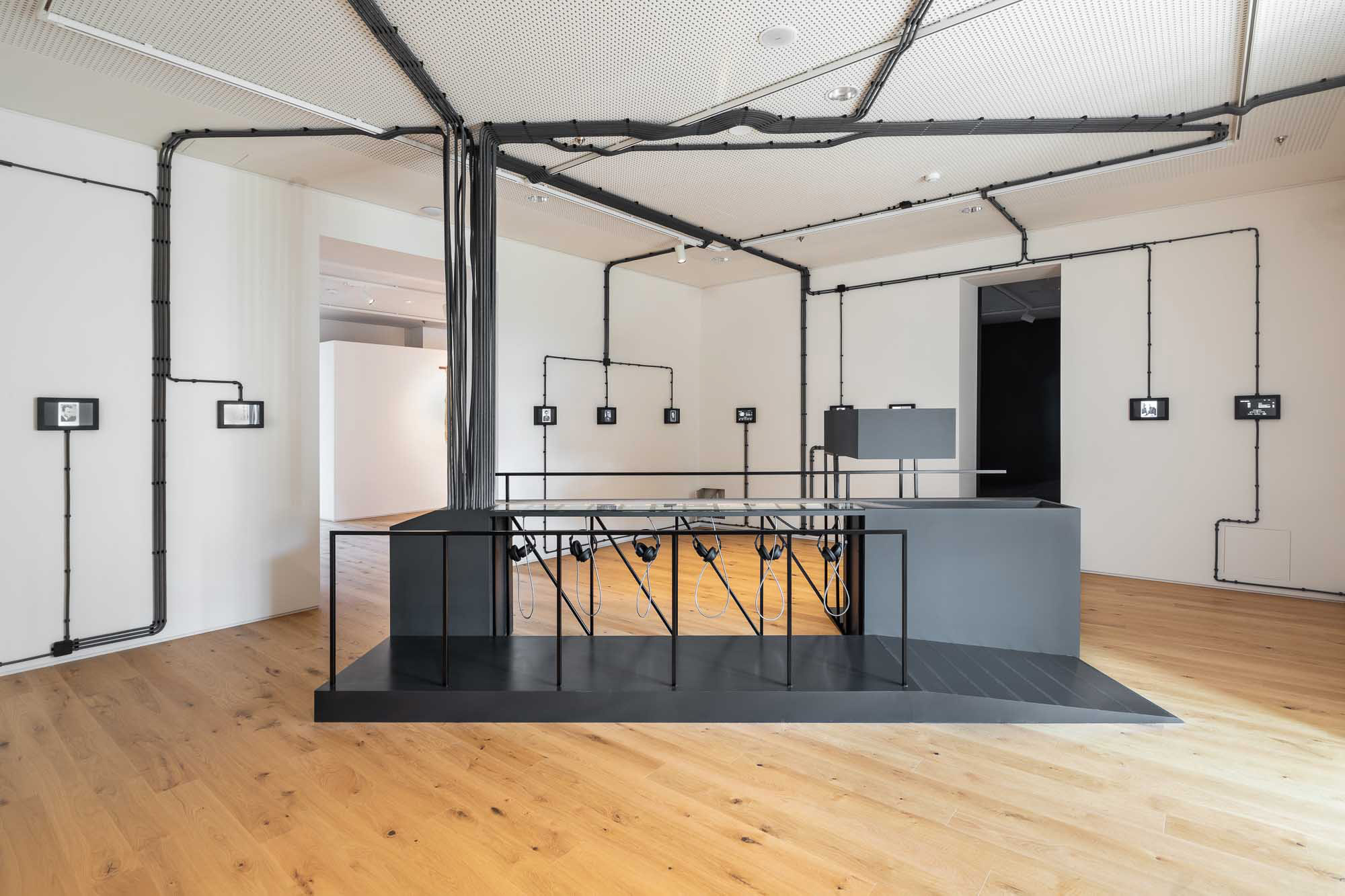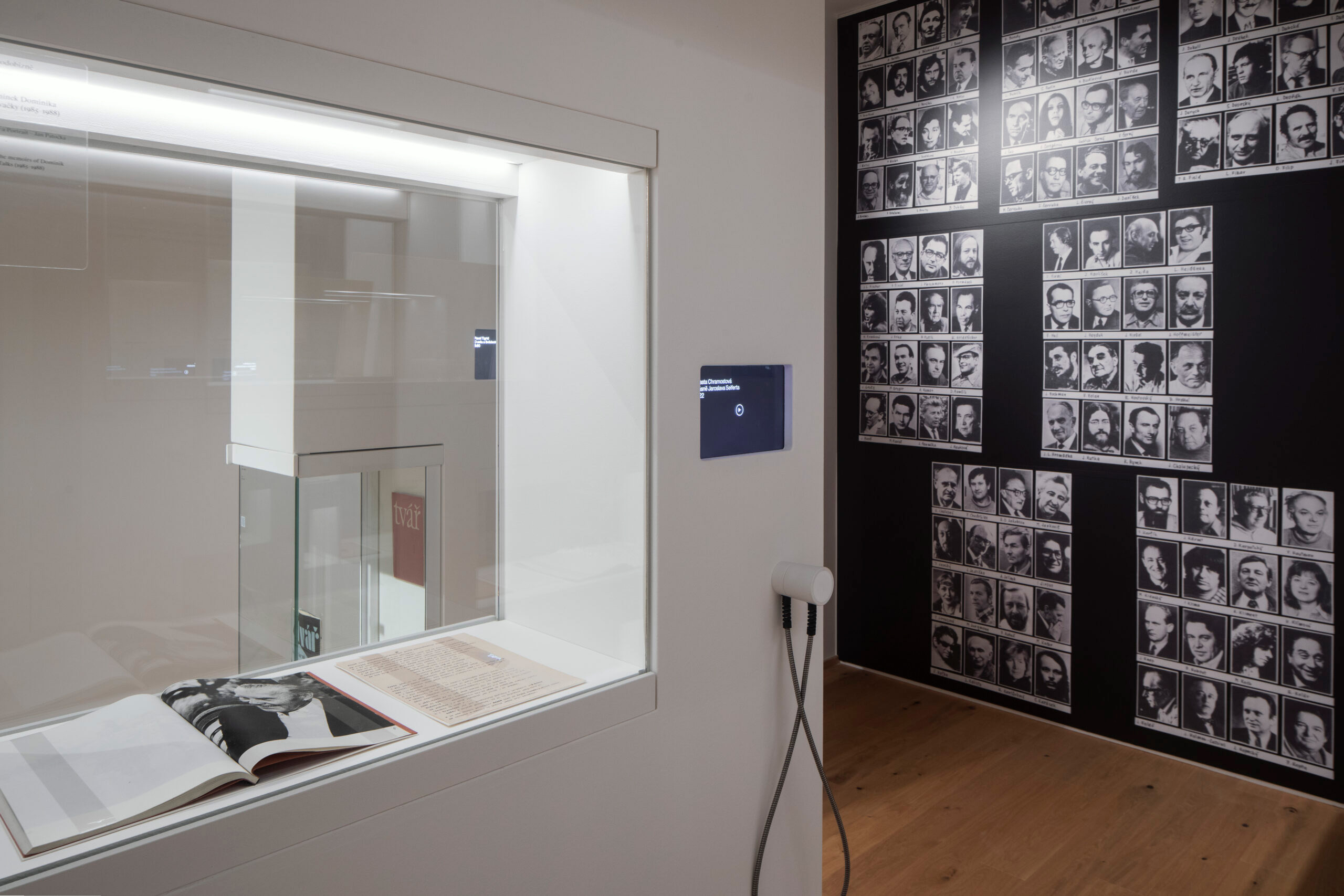Objektor architects’ exhibition spaces at the new Museum of
Czech Literature are a sequence of creative & curated exploration
A young architecture firm in Prague are slowly establishing
themselves on the Czech creative scene, in part due to their projects for
galleries & museums. A major recent example is their sequence of spaces for
the main exhibition galleries of the new Museum of Czech Literature in Prague
& recessed.space went along to have a look at their creative response to the
archive.
It can be hard for young architecture practices to emerge,
receive their first commissions, and establish themselves into the architectural
landscape. Prague-based Objektor Architekti is just one of these young
practices and they have found exhibition
design to have been a useful space to explore creative ambition, get attention,
and create spatial experiences that thousands of people experience.
Objektor were formed in 2017 when the founders, Václav Šuba and Jakub Červenka, were still studying at the Academy of Arts, Architecture and Design in Prague. From the beginning, they had ambitions for it not to go straight into the path of domestic extensions but pursue expanded notions of architecture, working at varying scales and typologies.
Over the last seven years their team has expanded as they have picked up increasingly larger commissions, including a cemetery that gently sits into the landscape alongside chestnut trees and a nearby chapel, and a recent commission for a primary school. Their recent Ovenecká 33 reimagination of a Prague apartment into a space for not only residential use but also artistic residencies and creative projects won awards and international coverage for its singular use of materials, light, and colour. Throughout, however, they have retained an interest in exhibition and gallery design as an architecture requiring specific qualities and considerations, whilst still offering plenty of scope for play and experimentation.
![]()
![]()
A few years ago, the national Museum of Czech Literature opened in a grand building in Bubenec, an area of Prague home to embassies and some of the city’s pricier flats. Only a short walk or tram ride from the tourist-packed historic city centre, it seems a different world. The museum, however, caters less to visiting mass-crowds and more for the people of Czezhia, and so in some ways its sense of removal from the dense heart of the capital city makes sense.
Objektor were awarded the task of creating the primary gallery spaces, a suite of ten rooms sequentially taking the visitor through the nation’s literature history. From the outset, the architects had creative agency not only with aesthetics and forms of display, but in curatorial conversations and ways in which the story might be explored to allow for diversification and diffraction from canon, cliché, and the expected.
![]()
![]()
![]()
Each of the rooms has its own visual identity, and as the visitor segues from one to another there’s a genuine moment of surprise along with the shift from one architectural approach to another. The sequence is only semi-chronological, each space instead formed around a different theme, spread across two floors. The story starts with The Czech National Revival, following the 1848 revolution when a new national identity was under formation, through to: how the 19th century fed into wider social structures in The 19th Century in Us, using found objects as a path to deeper critical idea; an exploration of Other Modern Writers, documenting the rise of the singular artistic voice; when art began to fuse with everyday life and politics within Visual Aspects of the Avant-Garde; an exploration of the rise of the solitary, lone artist through the work of writer Josef Váchal.
![]()
![]()
This is not a museum singularly focussed on that most (rightly!) celebrated Czech author, Franz Kafka, but instead the whole ecosystem of his contemporaries, as well as those who went before. This is explored in an early room, the Pantheon, presenting a variety of unexpected objects, each singularly connected in a curious way to a different writer. There are obvious literature-adjacent items, such as a feather quill, and then more obscure curios – an iron, a portable vitrine of stones, miniature porcelain animals, fragments of a skull. These all offer routes into different people and narratives, presented in a circular chamber with four anterooms tucked behind, offering spaces to sit, read books, and ponder. Throughout, Objektor’s approach has been one that pushes curiosity and shared joy while still creating such spaces for more intimate and personal reflection.
The sense of play is pushed through each room having its own distinct visual identity. This allows a sense of dramaturgy and discovery for the visitor, but is also a clever way to help the lifespan of the design. This is a permanent display, but over its life curators will change what is shown, switch content around, maybe develop or reconsider an entire themed space. If each of the ten rooms strictly followed a visual language and detailing, future shifts in the displays would be beholden to the rules set on day one. With this varied approach, individual elements can be changed or updated without impacting the feel of the whole.
A Critical Network is a space exploring the urgency of the pre-war period and a network of poets and writers who had formed a community, all of whom contributed to Critical Monthly journal. A huge black machine fills the room, visitors able to explore histories, biographies, works, and letters through touchscreens, which are all then sendable to the central computer where they can be printed and compiled into a personal collection.
![]()
![]()
![]()
A room exploring Other Modern Writers is presented on a slender red frame system, easily adaptable for the addition of new archive items or curated interventions through systems of shelves, Perspex display cases, and openings. Throughout, items which need to be shielded from the light are neatly hidden in retractable draws and slits. Colour is used through the sequences of spaces to interrupt and add identity, as too are graphic forms for seating and book displays.
Another method for Objektor to inject wit and fun into the design was through invitation to several contemporary artists and makers to produce artworks. These were from filmmakers and creatives the pair of architects met while studying in their interdisciplinary school, and the momentary interventions re-presenting individuals or thematic tropes with creative twists helps extract some of the ideas from solely historic moments into human or political ideas that might be useful to consider for today as well as for the past.
![]()
![]()
![]()
The final room explores cultural magazines between 1959 and 1989, when the Communist Party of Czechoslovakia monitored and enforced cultural production strictly. The architecture of this space is densely packed, a maze of restrictively narrow passages full of zines, posters, and writings from creatives fighting for a different nation. Cuts into the display walls add respite from the compressive experience, also offering glimpses of other writers and works, poetically reflecting the experiences of being a creative in such a period, maybe only partially aware of others also writing, making, and agitating without a central, open forum.
The curation here benefits from a co-production with the architects that went beyond an aesthetic flourish, but was a shared exploration between the curators and Objektor of the archive, underlying themes, and how they can best be considered spatially and critically. It results in a robust and durable permanent installation, flexible enough to be adapted and updated as needs be, but still hold a collective form and sequence.
Objektor were formed in 2017 when the founders, Václav Šuba and Jakub Červenka, were still studying at the Academy of Arts, Architecture and Design in Prague. From the beginning, they had ambitions for it not to go straight into the path of domestic extensions but pursue expanded notions of architecture, working at varying scales and typologies.
Over the last seven years their team has expanded as they have picked up increasingly larger commissions, including a cemetery that gently sits into the landscape alongside chestnut trees and a nearby chapel, and a recent commission for a primary school. Their recent Ovenecká 33 reimagination of a Prague apartment into a space for not only residential use but also artistic residencies and creative projects won awards and international coverage for its singular use of materials, light, and colour. Throughout, however, they have retained an interest in exhibition and gallery design as an architecture requiring specific qualities and considerations, whilst still offering plenty of scope for play and experimentation.


A few years ago, the national Museum of Czech Literature opened in a grand building in Bubenec, an area of Prague home to embassies and some of the city’s pricier flats. Only a short walk or tram ride from the tourist-packed historic city centre, it seems a different world. The museum, however, caters less to visiting mass-crowds and more for the people of Czezhia, and so in some ways its sense of removal from the dense heart of the capital city makes sense.
Objektor were awarded the task of creating the primary gallery spaces, a suite of ten rooms sequentially taking the visitor through the nation’s literature history. From the outset, the architects had creative agency not only with aesthetics and forms of display, but in curatorial conversations and ways in which the story might be explored to allow for diversification and diffraction from canon, cliché, and the expected.



Each of the rooms has its own visual identity, and as the visitor segues from one to another there’s a genuine moment of surprise along with the shift from one architectural approach to another. The sequence is only semi-chronological, each space instead formed around a different theme, spread across two floors. The story starts with The Czech National Revival, following the 1848 revolution when a new national identity was under formation, through to: how the 19th century fed into wider social structures in The 19th Century in Us, using found objects as a path to deeper critical idea; an exploration of Other Modern Writers, documenting the rise of the singular artistic voice; when art began to fuse with everyday life and politics within Visual Aspects of the Avant-Garde; an exploration of the rise of the solitary, lone artist through the work of writer Josef Váchal.


This is not a museum singularly focussed on that most (rightly!) celebrated Czech author, Franz Kafka, but instead the whole ecosystem of his contemporaries, as well as those who went before. This is explored in an early room, the Pantheon, presenting a variety of unexpected objects, each singularly connected in a curious way to a different writer. There are obvious literature-adjacent items, such as a feather quill, and then more obscure curios – an iron, a portable vitrine of stones, miniature porcelain animals, fragments of a skull. These all offer routes into different people and narratives, presented in a circular chamber with four anterooms tucked behind, offering spaces to sit, read books, and ponder. Throughout, Objektor’s approach has been one that pushes curiosity and shared joy while still creating such spaces for more intimate and personal reflection.
The sense of play is pushed through each room having its own distinct visual identity. This allows a sense of dramaturgy and discovery for the visitor, but is also a clever way to help the lifespan of the design. This is a permanent display, but over its life curators will change what is shown, switch content around, maybe develop or reconsider an entire themed space. If each of the ten rooms strictly followed a visual language and detailing, future shifts in the displays would be beholden to the rules set on day one. With this varied approach, individual elements can be changed or updated without impacting the feel of the whole.
A Critical Network is a space exploring the urgency of the pre-war period and a network of poets and writers who had formed a community, all of whom contributed to Critical Monthly journal. A huge black machine fills the room, visitors able to explore histories, biographies, works, and letters through touchscreens, which are all then sendable to the central computer where they can be printed and compiled into a personal collection.



A room exploring Other Modern Writers is presented on a slender red frame system, easily adaptable for the addition of new archive items or curated interventions through systems of shelves, Perspex display cases, and openings. Throughout, items which need to be shielded from the light are neatly hidden in retractable draws and slits. Colour is used through the sequences of spaces to interrupt and add identity, as too are graphic forms for seating and book displays.
Another method for Objektor to inject wit and fun into the design was through invitation to several contemporary artists and makers to produce artworks. These were from filmmakers and creatives the pair of architects met while studying in their interdisciplinary school, and the momentary interventions re-presenting individuals or thematic tropes with creative twists helps extract some of the ideas from solely historic moments into human or political ideas that might be useful to consider for today as well as for the past.



The final room explores cultural magazines between 1959 and 1989, when the Communist Party of Czechoslovakia monitored and enforced cultural production strictly. The architecture of this space is densely packed, a maze of restrictively narrow passages full of zines, posters, and writings from creatives fighting for a different nation. Cuts into the display walls add respite from the compressive experience, also offering glimpses of other writers and works, poetically reflecting the experiences of being a creative in such a period, maybe only partially aware of others also writing, making, and agitating without a central, open forum.
The curation here benefits from a co-production with the architects that went beyond an aesthetic flourish, but was a shared exploration between the curators and Objektor of the archive, underlying themes, and how they can best be considered spatially and critically. It results in a robust and durable permanent installation, flexible enough to be adapted and updated as needs be, but still hold a collective form and sequence.
Objektor was formed in 2017 while Václav Šuba & Jakub
Červenkawere were studying at the Academy of Arts, Architecture and Design in
Prague as a platform for cooperation in the field of Architecture and its
related subjects. From then on, they have been worked on projects of various
scales and typologies. Our team now focuses both on small scale objects and
larger architectural assignments.
www.objektor.cz
www.objektor.cz


